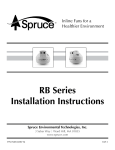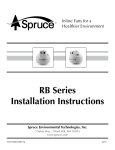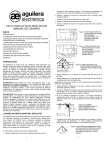Download SerieT Sub-Bass Systems
Transcript
SerieT Sub-Bass Systems Opera0ng Instruc0ons for the 1 2 3 4 5 6 7 8 9 Important Safeguards Read all of these instruc0ons. Save these instruc0ons for future use. Unplug from the wall socket before cleaning. Do not use near water. Do not place on a stand or table; it may fall causing injury to a child or adult, and damage to the unit. The unit should only be operated from the power source indicated on the panel of the amplifier. Only use the power cord supplied. Do not allow anything to rest on the power cord. Posi0on the power cord such that it cannot be walked on. For added protec0on during a lightning storm, or when not in use for long periods of 0me, unplug it from the wall socket. 10 Never spill any kind of liquid on the unit. 11 Do not a1empt to service the unit yourself, as removing the amplifier may expose you to dangerous voltages. Refer all servicing to your dealer. 12 Unplug the unit from the wall socket and refer servicing to your dealer under the following condi0ons: a When the power cord or plug is damaged. b If liquid has been spilled onto the unit. c If the unit does not operate properly by following the opera0ng instruc0ons. d If the unit has been dropped and damaged. e When the unit exhibits a dras0c change in performance. Warning This item is heavy. To avoid risk of injury, take care when handling. Design Safety This apparatus is supplied with a detachable mains cord. For 230V opera0on a 1.6A/T5, 2A/T7, 3.15A/T9 fuse is fi1ed in the socket. For 115V opera0on a 3.15A/T5, 4A/T7, 6.3A/T9 fuse is fi1ed. Should the fuse need to be replaced use a similar rated fuse approved to ASTA or BSI 362 standards. Do not use without the fuse cover in place. Replacement fuse covers are available from your distributor. 1 Welcome to the REL Family Thank you for buying a REL Serie T Sub-Bass System. The Serie T is the result of a state-of-the-art collabora0on between our American design and engineering team and our Bri0sh produc0on team. Serie T is conceived as the most cost effec0ve high end product we know how to build. We have spared none of the materials and finishing techniques our larger designs are noted for. Many compe0ng products are clearly the result of cost engineering, however, Serie T is a pure high end product in design and execu0on. If, like many, you are surprised and delighted by the quality and “suddenness” of bass as rendered by Serie T, know that this is the result of a careful, painstaking itera0ve process of the sort that so rarely makes it into produc0on at anything like these prices. Many of the sonic virtues – speed, warmth and slam – embodied in Serie T are the direct result of mechanical and acous0c advancements. In par0cular, we have u0lized damping and resonance control approaches more familiar to fine acous0c instrument manufacturers incorpora0ng bracing that is highly unusual in this applica0on. The bracing is carefully wedged into shallow channels in the side and top wall material which be1er couples the energy control of these panels. Addi0onally, the aluminium feet are milled from solid billet and weigh an incredible amount. We thoroughly tested and were able to clearly discern the benefit of having a solid, high mass exit path for deleterious vibra0on; vibra0on that would otherwise slow and blur the clarity of bass lines. Make a structure inert and quieter and more of the music emerges. A brief word about the styling, fit, and finish. Each Serie T receives nine coats of lacquer, all of which require hand sanding. The final coat is then turned by hand on a large, industrial rouging wheel using jewelry buffing compound. Finally, the deep, wet gloss is achieved by hand polishing using micro fibre cloth and expensive a!ermarket waxes. All exposed bolts used to a1ach the rear panel to the Serie T cabinet are polished T-304 stainless steel allen head designs. This extra cost is undergone to ensure that even in humid markets RELs will not oxidize or degrade in appearance. Each badge is milled from solid billet aluminium and is a full 2.5mm thick even though we choose to only reveal 1mm above the surface of the cabinet. Much like the underlying quality of all RELs, more lies beneath the surface than is evident to the eye. 2 Overview: Serie T Sub-Bass Systems Many or most loudspeakers emphasize the mid-bass. This is the range from 50 to 90 Hz. We at REL believe this is an incomplete approach and that loudspeakers need to be extended in the lower frequencies for true full range reproduc0on. All of our designs are true Sub-Bass Systems, meaning they are designed to reproduce very low frequencies (below 30 Hz) that are felt rather than heard. This is because we understand that music is full-range, as are sound effects on movies, and we intend for our products to reproduce all of these sounds, not just a narrow band. Serie T is equipped to allow you to take full advantage of Dolby Digital AC3, DTS, MPEG 2 and any other digital sound format that includes a dedicated Low Frequency Effects (LFE) channel. The dedicated LFE input meets the tough specifica0on laid down for digital 3/2.1 channels, usually known as 5.1. The output is nominally flat from 35 Hz – 90 Hz. It has a dedicated input level control which enables users to set the LFE level independently of the processor. This is important because not all processors offer control over this significant parameter. The LFE channel is frequently output at 10 dB higher levels than the other channels. The Serie T models also have high-level (speaker level) inputs with dedicated input level control. Uniquely, both the speaker level and the LFE input can be used simultaneously. This means you may set it up for the best possible 2-channel performance sound with your CDs or other stereo signals and instantly revert to using the Sub-Bass System as the dedicated LFE component when watching movies. This is a feature of real benefit if you wish to play music in stereo mode in the purist audiophile way and also in REL Theater Reference mode with no switching necessary. By connec0ng BOTH High Level and .1 concurrently and se2ng your processor to “Large” or Full Range, the best possible performance will be obtained. Consult the owner’s manual of your loudspeakers or consult with your dealer before se2ng to large as a few speakers cannot handle the bass that is then directed through to the main speakers. 3 REL Serie T Rear Panel Connec)on Legend 1 4 2 5 3 6 7 8 9 4 1 Volume Control for .1/LFE INPUT: Use to adjust output level when using .1/LFE input from a 5.1 amplifier or processor. 2 Volume Control for HI/LOW INPUT: Use to adjust output when using either HIGH-LEVEL or LOW-LEVEL input. Do not use both simultaneously. 3 Crossover: Used to select crossover frequency. Variable between 30Hz and 120Hz. 4 .1/LFE INPUT: Used to connect to the .1/LFE output from a 5.1 amplifier of processor. Should be used in conjunc0on with REL HIGH-LEVEL connec0on for the ul0mate theater experience. 5 LOW-LEVEL INPUT: Used to connect LOWDLEVEL to the output of a preamplifier, integrated amplifier or receiver ONLY when HIGHDLEVEL INPUT cannot be properly connected. (For home cinema, use .1/LFE INPUT). 6 Phase: Used to set phase 0-180 degrees. 7 HIGH-LEVEL INPUT (Neutrik® Speakon® Socket): Use to connect HIGHDLEVEL to the main front amplifier speaker terminals. 8 Power ON/OFF Switch: Use to turn unit on or off. 9 IEC Mains Socket: Fused mains (AC) input socket that accepts a detachable power cord. 5 Connec)ng Up Always switch off your system before disconnec0ng any wires. ALWAYS connect using the REL HIGHDLEVEL input, unless your system simply cannot accommodate this. While rare, a few esoteric systems, such as those that deliver a pure digital signal to ac0ve speakers preclude this possibility. To increase the versa0lity of connec0ng up, the Serie T models have three separate inputs. A Neutrik Speakon socket and two phono sockets. This is to facilitate use with both two-channel stereo systems and AV surround sound systems. The HIGHDLEVEL, unbalanced, dual-channel (stereo) input is via a Neutrik Speakon connector which is connected to the power amplifier’s le! and right channel speaker terminals. This has the advantage of ensuring that the REL receives exactly the same signal as the main speakers. This means that the character of the bass from the main system is carried forward into the sub-bass. This is a very important point and together with the REL’s Ac0ve Bass Controller (ABC) ensures far superior system integra0on of the sub-bass with the main system. The LOWDLEVEL input is via a phono jack that connects to either the .1/LFE output of a home cinema amplifier/processor or to the output of a stereo preamplifier. HIGH-LEVEL and .1/LFE inputs can be used simultaneously. The benefits are two-fold when used with a home cinema system. The .1 Input reproduces the .1/LFE channel and the HIGHDLEVEL connec0on underpins the main front speakers. The main front speakers should be set to the ‘large’ op0on on the processor. See “Home Cinema Applica0ons” for more informa0on. Connecting to the Power Amplifier Using the Speakon HIGH LEVEL INPUT To engage the Neutrik Speakon plug, insert fully into socket and rotate clockwise un0l locked. To remove the Neutrik Speakon plug, grip body of plug, place thumb on chrome lever, move lever backwards, rotate plug an0clockwise quarter turn and withdraw. The HIGHDLEVEL input is designed to accept the stereo (two-channel) signals from the speaker terminals of your receiver, integrated amplifier or basic amplifier. This has the advantage of ensuring that your subwoofer receives exactly the same signal as the main speakers, which means that the character of the bass from the 6 main system is carried forward into the Sub-Bass System. This is a very important point and together with REL’s Natural RollOff™ circuitry, ensures far superior system integra0on of the Sub-Bass System with the main system. HIGH2LEVEL INPUT: Connec0ons should be made to the same binding post on main amplifier as the main speakers. Red to amplifier main right speaker red terminal, yellow to amplifier main le! speaker red terminal and black to amplifier main speaker black terminal, right or le! but not both. Plug the Neutrik Speakon plug into the HIGHDLEVEL Speakon socket. Note: This connec0on does not draw power from the power amplifier and, yes, your REL is a powered sub bass system. However, by deriving its signal from the main power amplifier, be1er sound quality is achieved. .1 INPUT: This requires a phono-to-phono cable and is a dedicated true .1 channel. This circuit therefore eliminates the normal Natural RollOff™ Crossover and passes the .1 LOWDLEVEL signal through with only the required 120Hz fourth-order filter. LOW2LEVEL INPUT: This single channel phono input allows for conven0onal connec0on to a preamplifier and should be used in the rare event that a HIGHDLEVEL connec0on proves incompa0ble. Plug one end of a single phono-phono cable into the LOW-LEVEL input jack of the REL and the other end into either the le! or right channel output of your preamplifier. Because much sub-35Hz bass informa0on is mono, there is li1le need to connect both le! and right channels. Should your system require this style of connec0on – HIGHDLEVEL is preferred – addi0onal performance is available by purchasing a second, matching REL and running each as separate stereo subs. PHASE SWITCH – Used to set phase Posi0on 0 / HIGHDLEVEL, LOWDLEVEL or LFE: 0 degrees phase Posi0on 180 / HIGHDLEVEL, LOWDLEVEL or LFE: 180 degrees phase PHASE SELECTION AFFECTS BOTH HIGH- AND LOW-LEVEL INPUTS Crossover is always engaged for HIGHDLEVEL INPUT. The .1/LFE signal does not pass through the crossover circuit. 7 REL Set-Up Made Simple REL products are not tradi0onal subwoofers, but are true Sub-Bass Systems. A REL is designed to augment the performance of “full range” speaker systems in order to provide, in certain cases, linear response below 12 Hz. Therefore, for the moment, set aside everything you’ve been taught about subwoofers and how they are integrated into a stereo or home cinema system. REL Sub-Bass Systems set-up and posi0oning differs from conven0onal subwoofers. A REL will take advantage of physics and room acous0cs to provide deep pressuriza0on as no tradi0onal subwoofer can. It is important that you bring to the set-up process a willingness to do things a li1le differently in order to obtain these superior results. The end result of your labours will be an u1erly seamless integra0on of true deep bass to a sound system, regardless of the main speakers’ low bass capability. Basic set-up should take no more than ten to fi!een minutes to accomplish once connected. Before You Begin 1 It is helpful to know that you will almost always connect the REL to the input on the rear panel labeled “HIGH-LEVEL INPUT.” This connec0on is made using the supplied 34’, 10” (10 meters) cable, the bare leads of which connect to the speaker output terminals of the power amplifier. The easy and foolproof connec0on at the REL is done with a Neutrik Speakon connector. The purpose of connec0ng to the speaker output terminals is one of the unique secrets of REL’s success. By connec0ng to the high-level input on the REL from the amplifier, you build forward the sonic signature of your main system, including the tonal balance and 0ming cues of the en0re electronics chain. In this way, the REL is fed the exact signal that is fed to the main speakers. 2 When possible, the REL should be placed in one of the corners behind the speakers. Remember, we are dealing with true LOW bass pressuriza0on with RELs. Low bass pressuriza0on below 40Hz is best derived from corner placement, where the most linear and efficient low bass can be produced. Connec)ng and Se*ng Up HIGHDLEVEL connec0on, using the enclosed cable with the Neutrik Speakon connector, is always the first choice. This connec0on can be made without affec0ng the performance of the amplifier because the REL’s amplifier input impedance is 150,000 ohms, in effect not producing any addi0onal demand whatsoever on the rest of your system. 8 • The standard HIGHDLEVEL hook up procedure is: a1ach the red wire to the amplifier’s right posi0ve speaker output terminal; a1ach the yellow wire to the amplifier’s le! posi0ve speaker output terminal; a1ach the black wire to whichever of the amplifier’s ground output terminals is convenient; plug the Speakon connector into the Sub-Bass System’s HIGHDLEVEL input. Supplied Neutrik Speakon HIGH-LEVEL Interconnect Yellow Black HIGH-LEVEL Input Red Release Lever + L – + R – Amplifier Main Speaker Outputs • For differen0al (i.e. fully balanced) amplifiers using one REL, simply use the standard connec0ng scheme with the excep0on of connec0ng the black wire to chassis ground (i.e. a metal bolt or screw, preferably not painted or anodized, on the chassis of the power amp or receiver), not to a nega0ve speaker terminal, and then connec0ng into the HIGH-LEVEL input on the REL. Please contact your dealer should there be any ques0ons concerning this or any other hookup procedure. Supplied Neutrik Speakon HIGH-LEVEL Interconnect Black Yellow Red Chassis Screw + + L – + R – Amplifier Main Speaker Outputs NOTE: The Serie T models are equipped with internal circuitry to allow seamless connec"on to Class-D (digital) main amplifiers. If connec"ng to a Class-D amplifier, follow the above connec"on procedure for differen"al amplifiers. 9 • If connec0ng two RELs in a stereo configura0on, connect the black wire of each REL to the nega0ve speaker terminal of the corresponding amplifier channel; twist together the red and yellow wires of each REL separately and connect each pair to the posi0ve speaker terminal of the corresponding amplifier channel. Supplied Neutrik Speakon HIGH-LEVEL Interconnect Left Sub Supplied Neutrik Speakon HIGH-LEVEL Interconnect Yellow Red Black Yellow Red + L – Right Sub Black + R – Amplifier Main Speaker Outputs • If connec0ng a single REL as a dedicated center channel sub, connect the black wire of the REL to the nega0ve center channel speaker terminal; twist together the red and yellow wires and connect this pair to the posi0ve center channel speaker terminal. Supplied Neutrik Speakon HIGH-LEVEL Interconnect Yellow Red Black + C – Amplifier Main Speaker Outputs 10 • If connec0ng a REL as a dedicated rear channel sub, connect the black wire of the REL to either the le! rear or right rear nega0ve speaker terminal; connect the yellow wire to the le! rear posi0ve speaker terminal; connect the red wire to the right rear posi0ve speaker terminal. Supplied Neutrik Speakon HIGH-LEVEL Interconnect Yellow Black Red + RL – + RR – Amplifier Main Speaker Outputs LOWDLEVEL connec0on (via phono connector) is always an op0on if HIGHDLEVEL connec0on is not possible. When connec0ng to the LOWDLEVEL inputs in a system in which HIGHDLEVEL connec0on is not possible, such as if using internally-amplified speakers, connect a single phono cable between the LOW-LEVEL input jack of the REL and either the le! or right channel output of your preamplifier. Because virtually all sub-35Hz bass informa0on is mono, there is no need to connect both le! and right channels. When connec0ng to a home cinema system where an .1/LFE channel output is present, connect a single phono cable between the sub output of the processor/receiver and the .1/LFE input jack on the REL. Posi)oning: The op0mal posi0on for a REL is in one of the corners behind the main speakers. This posi0on provides 9 dB of acous0c amplifica0on and allows for the most linear true low bass wave launch, owing to the ability to tune the REL to the longest distance in the room in order to produce the longest, therefore lowest, bass waves. The Process: To begin the set-up process, choose a piece of music that has a repe00ve bass line that is very low in frequency. We suggest track four from the soundtrack to Sneakers (Columbia CK 53146). This has a repe00ve bass drum throughout that gives you plenty of 0me to move the woofer around, but more importantly, the venue was quite large for this recording, and therefore it has a very deep and large-scale bass signature. This type of track is perfect for the set-up process and should be played at the highest reasonable level expected for system playback. 11 Working with a partner, one in the listening posi0on and one at the REL manipula0ng the controls, is the most effec0ve and efficient way to set up the REL. If working alone, the ini0al steps in the set-up can be very effec0vely carried out from the loca0on of the REL. Trying to ignore all other music in the track, listen for the bass drum and its effect on the listening room. Phase Orienta)on: Once in the corner phase can be adjusted. This may be the single most cri0cal step, and because it really is quite simple, it is o!en over-thought. Keep in mind; the right phase is whichever posi0on is the loudest or fullest. While playing music with true low bass, adjust the crossover to a point where the REL and the speaker are sure to share frequencies (about halfway up, or at 12 o’clock on the crossover control, or slightly higher for smaller speakers). At this point turn the HI/LOW LEVEL control up so that both the REL and speaker are roughly equal in volume and then switch, using the phase switch, from “0” to “180” phase posi0ons. Again, whichever posi0on is loudest or fullest is the correct posi0on. That is, when the posi0on is working in harmony with your main speakers, reinforcing bass, not cancelling it. Placement: The next step is to determine precisely how far from the corner the sub should be placed to achieve the most efficient output, as well as the lowest frequency extension. With the REL fully into the corner, and poin0ng straight out along the diagonal coming out of the corner, con0nuing to play the music, slowly pull the REL from the corner on the diagonal, equidistant from both side and rear wall. At a certain point (some0mes a ma1er of only a few inches, in rare cases a foot or more) the REL will audibly go lower, play louder, and, if it truly locks on to the room and is fully pressurizing it, the air around the REL will seem to be energized, stop right there! This is the correct posi0on from the corner for the REL. Crossover and Level Se*ngs: To determine the crossover point, take the volume of the REL (using the HI/LOW LEVEL control) all the way down, and put the crossover to 30 Hz. At this point, bring the REL’s volume back up slowly to the point where you have achieved a subtle balance, i.e. the point at which you can hear the REL even with the main speakers playing. Now, bring the crossover point up un0l it is obviously too high; at this point bring it down to the appropriate lower se2ng. For all intents and purposes, this is the correct crossover point. Once this stage has been reached, subtle changes to volume and crossover can be accomplished to provide the last bit of complete and seamless integra0on. With that, set-up is complete. 12 Hint: There may be a tendency to set the crossover point too high and the volume of the Sub-Bass System too low when first learning how to integrate a REL with the system, the fear being one of overwhelming the main speakers with bass. But in doing so, the resul"ng set-up will be lacking in bass depth and dynamics. The proper crossover point and volume se#ng will increase overall dynamics, allow for extended bass frequencies, and improve soundstage proper"es. Note, volume must be adjusted in conjunc"on with crossover changes. In general, when selec"ng a lower crossover point, more volume may need to be applied. REL Theater Reference™ Home Cinema Applica)ons For Dolby Digital AC3 or other 5.1 theater systems, once the standard set-up for two-channel outlined above is complete, the LFE output from the processor or receiver should be connected to the .1/LFE input and appropriate volume adjustments made using the .1/LFE LEVEL control. For this configura0on, you must set the processor to the “large” or “full range” se2ng for the le! and right speakers in order for the REL to receive the bass signal via the high-level cable. In this configura0on, the REL provides support for both the le! and right speakers for two-channel listening, and support for the LFE when movies are playing. Most processors will allow you to defeat the subwoofer output when listening in the two-channel mode. The effect of this set-up is one of greatly increased dynamics in the mid-bass range, no bass bloat, and a greater degree of space and 0ming from the special audio effects. REL Theater Reference 3D Bass™ While slightly more complicated than the basic REL Theater Reference scheme, use of three RELs produces a number of noteworthy benefits and proves the most cost effec0ve method of achieving professional Dolby 5.1 standard bass performance. REL Theater Reference 3D Bass™ produces true full range performance from the three primary zones of reproduc0on in theater sound resul0ng in a far more natural and immersive experience than ANY single sub can produce. 1 The main L/R speakers should be connected to the primary REL using REL Theater Reference connec0on. This unit forms the founda0on of your theater system’s performance and so should be perfectly matched to one’s main speakers. 13 2 In the rear corner (ideally that which is opposite the primary sub), connect a second REL to the rear speakers using REL Theater Reference connec0vity. The purpose of the rear channel REL is to ensure proper front-to-rear balance and weight; too o!en virtually ALL the power and weight in a theater comes from the front and it produces unnatural weigh0ng as well as hot spots. By placing a rear REL diagonally opposite, bass transects the room on a tangent and has the effect of greatly smoothing overall in-room response of your RELs. This unit need not be a duplicate of your primary REL, instead it should match well with your surround speakers. 3 Connect to the center channel a third REL using ONLY the HIGHDLEVEL connec0on. This may be easily accomplished by connec0ng directly to the connec0on terminals on the rear of the center channel speaker. To do so, first twist the red and yellow leads together and connect to the posi0ve terminal, then connect the remaining black lead to the nega0ve (black) terminal on the rear of the speaker. The purpose of the third “center” REL is to ensure the center channel can keep up with the scale, weight and dynamics the main system now has. Loca0on should be anywhere from the opposite corner of the front wall to somewhere in the middle of the front wall, listen for best integra0on with the center channel speaker. Some people prefer to use the REL as an actual pediment or stand for their center channel, the choice is yours. Again, this unit need NOT be an exact duplicate of the primary REL but should be chosen for its acous0c ability to mate seamlessly with your center channel. First, carefully set-up and dial in the primary REL, then move to the rear REL and balance this against the main REL. Care must be taken to ensure phase is iden0cal on both RELs as accidentally reversing phase of one rela0ve to the other will result in a drama0c reduc0on in bass output. Finally, carefully dial in the performance of the center channel sub. Hint: To make this easier, once the primary REL has been dialed in, unplug it using the Speakon connec0on from the system and dial in the rear, followed by the center channel REL. Genuine s0cklers for perfec0on find it easiest to tune in sec0ons. For example, connect ONLY the L/R mains and the primary REL. Next, tune ONLY the rear surrounds and the rear REL. Finally, listen to and tune ONLY the center channel with the center REL. 14 When you have accomplished this task, plug all three units in and re-check your gain se2ngs as the cumula0ve effect of hooking all three up will usually result in, temporarily, excessive output. Work carefully and methodically to reduce the se2ngs on primary, then rear, and finally center channel RELs and in a few minutes balance should be restored. However, the net result of all your tuning will be a sound that u1erly immerses the theater owner in a rich natural wash of bass that suffuses the room effortlessly, rather than what is o!en experienced as too loud a bass balance pushing uncomfortably at the listener. Running In Care taken over running in will be rewarded by many years of pleasurable use. Both the electronics and the drive unit will benefit from an ini0al period of carefully controlled use. Possible damage may be sustained by running in the unit at too high a volume se2ng over an extended period. On the other hand, by taking a li1le care over this ini0al period, about 24 hours of actual use, a longer life with an eventual higher poten0al performance is assured. Care and Polishing The cabinets are best maintained by using a light automo0ve spray-on wax and a micro fiber cloth. (We use a spray-on made by a company called Griot’s Garage™. While this may not be available in all markets, you can use a similar product.) Take care not to spray the aluminum badges. Do not place objects, such as drinks on top of your REL Serie T. Never use a dry cloth on this finish. Technical Serie T uses a very fast, gentle and transparent filter intended to allow excellent impulse response and a natural sound. We refer to this circuit as Natural Rolloff™. Most subs use slow, very steep filters that lend an unnatural, machine-like quality to the sound. The Serie T power amplifiers are conven0onal Class A/B linear power supply amplifiers – unusual at this price as most designs use a simple Class D amp. These designs feature robust, high current power supplies and are bulletproof. Our priority is for the most reliable circuit we know and we have logged millions of hours of playing 0me with a resultant failure rate that is the envy of the industry. The drivers are simple, rugged, rela0vely light, and yet offer excellent self-damping so we are be1er able to reproduce the nuance of music and preserve the explosiveness of transients. Finally, the cabinets, apart from being physically beau0ful, are like finely tuned instruments that are largely responsible for the sonic virtue with which Serie T is imbued. 15 Power Saving Efficiency All REL Sub-Bass Systems are designed for maximum power efficiency, both when passing a signal through to its resultant output sound into the room and also when silent. REL circuitry allows for “power starva0on” opera0on under no signal condi0ons. This means that when there is a gap in the signal the REL is instantly at maximum power saving efficiency, yet remains at maximum readiness to respond immediately to a sudden transient signal (such as an explosion in a movie) even a!er a long quiet period and regardless of level. It is not necessary to switch your Serie T off between listening sessions – it will not significantly shorten its life by leaving it switched on. On the other hand, it will not harm sound quality if it is always switched off. It is perfectly safe to leave your Serie T on under all normal domes0c circumstances as it is fully protected by internal fuses and an external mains fuse in the fuse holder of the mains input socket. There is a spare inside this holder. 16 Specifica)ons T-9 Type: Ac0ve Drive Unit: Passive Radiator: Lower Frequency Response: Input Connectors: Input Impedance: Gain Control Range: Power Output: Phase Switch: Amplifier Type: Protec0on System Fully Electronic SET-SAFE: D.C. Fault: Output Short: Mains Input Voltage: Fuses: Dimensions (WHD): Passive Radiator, front-firing passive radiator, down-firing ac0ve woofer 10in., 254 mm long-throw, steel chassis 10in., 254 mm 28 Hz at -6 dB in room Hi Level Neutrik Speakon, Lo Level single phono, LFE phono High Level: 150k, Low Level: 10k, .1/LFE: 10k ohms 80 dB 300 Wa1s (RMS) Yes, 0 or 180 degrees Class AB Yes Yes Yes 220-240 volts, 110-120 volts for certain markets 3.15 Amp semi delay 230 volts opera0on, 6.3 Amp semi delay 115 volts opera0on 13 x 14.75 x 14.75 in., (330 x 374.6 x 374.6 mm) Including Feet and Rear Panel Controls 39 lbs. (17.7 kg) Gloss Piano Black or White Lacquer Net Weight: Finish: Supplied Accessories Mains Lead: Yes Neutrik Speakon Interconnect: Yes (10 Meters Nominal) Users Manual: Yes 17 T-7 Type: Ac0ve Drive Unit: Passive Radiator: Lower Frequency Response: Input Connectors: Input Impedance: Gain Control Range: Power Output: Phase Switch: Amplifier Type: Protec0on System Fully Electronic SET-SAFE: D.C. Fault: Output Short: Mains Input Voltage: Fuses: Dimensions (WHD): Passive Radiator, front-firing passive radiator, down-firing ac0ve woofer 8in., 200 mm long-throw, steel chassis 10in., 254 mm 30 Hz at -6 dB in room Hi Level Neutrik Speakon, Lo Level single phono, LFE phono High Level: 150k, Low Level: 10k, .1/LFE: 10k ohms 80 dB 200 Wa1s (RMS) Yes, 0 or 180 degrees Class AB Yes Yes Yes 220-240 volts, 110-120 volts for certain markets 2 Amp semi delay 230 volts opera0on, 4 Amp semi delay 115 volts opera0on 12 x 13.75 x 13.75 in., (305 x 349.2 x 349.2 mm) Including Feet and Rear Panel Controls 230V: 31 lbs. (14.1 kg) 115V: 34 lbs. (15.4 kg) Gloss Piano Black or White Lacquer Net Weight: Finish: Supplied Accessories Mains Lead: Yes Neutrik Speakon Interconnect: Yes (10 Meters Nominal) Users Manual: Yes 18 T-5 Type: Ac0ve Drive Unit: Lower Frequency Response: Input Connectors: Input Impedance: Gain Control Range: Power Output: Phase Switch: Amplifier Type: Protec0on System Fully Electronic SET-SAFE: D.C. Fault: Output Short: Mains Input Voltage: Fuses: Dimensions (WHD): Closed Box, down-firing ac0ve woofer 8in., 200 mm long-throw, steel chassis 32 Hz at -6 dB in room Hi Level Neutrik Speakon, Lo Level single phono, LFE phono High Level: 150k, Low Level: 10k, .1/LFE: 10k ohms 80 dB 125 Wa1s (RMS) Yes, 0 or 180 degrees Class AB Yes Yes Yes 220-240 volts, 110-120 volts for certain markets 1.6 Amp semi delay 230 volts opera0on, 3.15 Amp semi delay 115 volts opera0on 10.5 x 11.75 x 11.75 in., (266.7 x 298.4 x 298.4 mm) Including Feet and Rear Panel Controls 26 lbs. (11.7 kg) Gloss Piano Black or White Lacquer Net Weight: Finish: Supplied Accessories Mains Lead: Yes Neutrik Speakon Interconnect: Yes (10 Meters Nominal) Users Manual: Yes In the interest of product improvement, REL Acous"cs Limited reserves the right to alter these specifica"ons without no"ce. 19 REL Acous)cs Limited North Road, Bridgend industrial Estate . Bridgend, CF31 3TP . United Kingdom Telephone: +44 (0)1 656 768 777 . Fax: +44 (0) 1 656 766 093 Web: www.rel.net






























